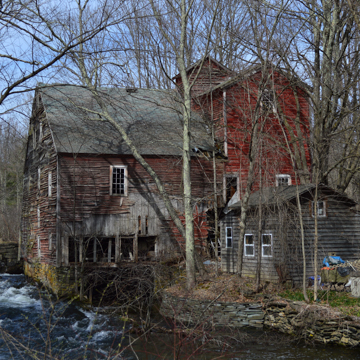In Vermont, the first commercial structure built during late-eighteenth-century settlement was usually a gristmill, which was considered such a community necessity that town proprietors frequently commissioned them. Often the victims of floods, no known eighteenth-century mills survive, but this two-and-a-half-story, gabled, wood-frame one was built by Roswell Goodrich in 1808, making it the state's oldest extant gristmill, and probably the oldest extant mill of any sort in Vermont. The brook is dammed about three feet and diverted into the wheelrace where a covered, undershot waterwheel provides power for the millstones. The small multi-paned windows provide an exterior clue to its early date, but the massive, early post-and-beam frame within confirms that this is Roswell's mill. He sold it to Abel Parker likely after the freshet of 1811 washed out the dam and wheelrace. Roswell moved west, but his son Halsey stayed in Vermont and purchased the gristmill in 1833, remaining here as a miller until his death in 1857. His widow, Julia, ran the mill with her sons Irving and Orville through the 1880s, adding a two-story grain hoist elevator and office at the southeast corner of the mill. Orville took possession by 1890 and operated it until its closure and his retirement around 1915. By then most farmers stopped raising their own grains and began purchasing flour and feed.
You are here
Goodrich Grist Mill
If SAH Archipedia has been useful to you, please consider supporting it.
SAH Archipedia tells the story of the United States through its buildings, landscapes, and cities. This freely available resource empowers the public with authoritative knowledge that deepens their understanding and appreciation of the built environment. But the Society of Architectural Historians, which created SAH Archipedia with University of Virginia Press, needs your support to maintain the high-caliber research, writing, photography, cartography, editing, design, and programming that make SAH Archipedia a trusted online resource available to all who value the history of place, heritage tourism, and learning.















